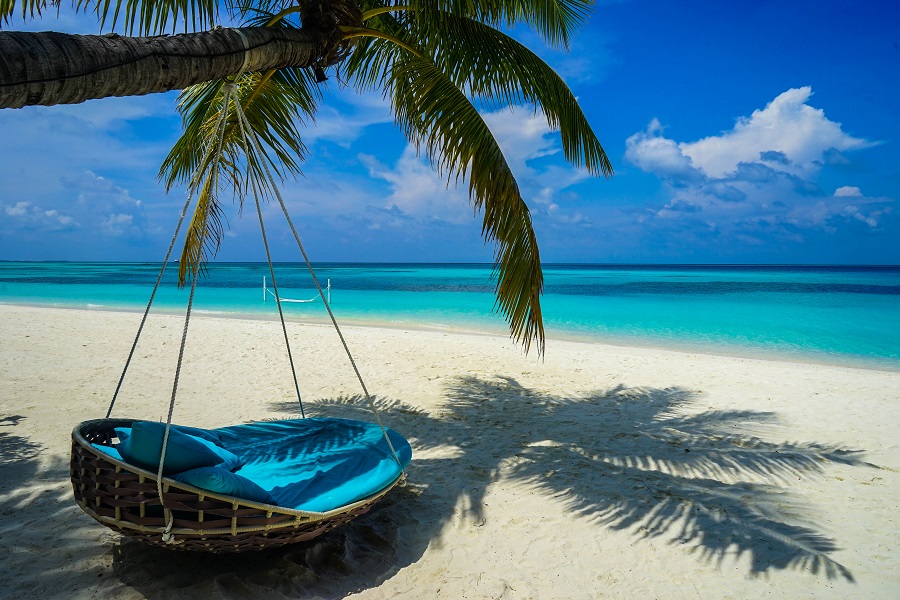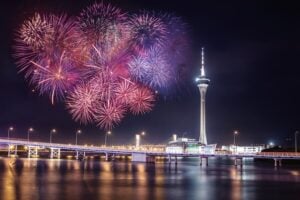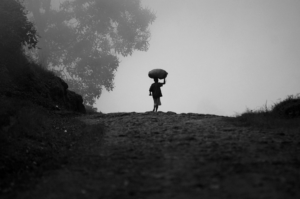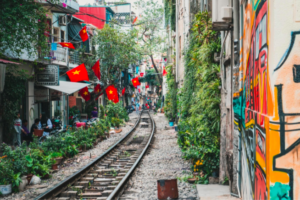Life below and above the water in the Maldives
The entire boat is tense, ready to spring into action. As we drive up and down the house reef, the crew scans the water for telltale white spots that mark the whale shark, the planet’s largest living fish species, “We might only have one shot. Don’t forget that these are wild animals,” warns marine biologist Mark McMillan, using a plushie to demonstrate how the boat will try to drop us in the path of the shark. “Otherwise, if you’re behind him, you’ll have no chance.”

Marine biologist Mark McMillan
All of a sudden, the boat revs its engine and makes for a point in the distance where a handful of other boats have congregated. “Go, go, go!” is the urgent call as we waddle across the deck, clumsy fins and a surge of adrenaline working at odds with each other. In the water, it’s a melee of arms and legs and churning bubbles. I orient myself and look down to where the guide is frantically pointing but see only a wall of dark blue. It’s crazy to think that I can’t spot a 6-meter-long shark until one suddenly emerges from the depths towards the surface. We all momentarily freeze as the behemoth effortlessly swims by, mouth agape, looking colossal. Then, with a flick of its crescent tail, it’s gone again.
Back on board, we’re breathless and giddy, rehashing our brief but magical experience with various forms of “Did you see it?” and “Yeah, it was AWESOME!” Not everyone joins in the celebration, though. One greenfaced couple dry heave over the side of the boat, overcome by exhaustion and seasickness, while a glum gentleman sits in the corner having lost his mask in the harried dive overboard, his dream of swimming with a whale shark ending before it even began. It seems every Eden, even one as extraordinarily beautiful as the Maldives, comes with a few bitter apples.

Image provided by LUX* South Ari Atoll
Back at LUX* South Ari Atoll, Mark sinks his toes into the sandy floor of his office as the resort’s resident marine biologist. “This area is so rich in marine life,” he says, recalling a day last year where he spotted three whale sharks and eight manta rays on a single snorkeling trip. “One of the best parts of my job is being able to show guests this side of the Maldives. We do so much more than throw guests in the water to see a shark. The tours are designed to be educational, to set the example on how to interact with the wildlife for both the safety and welfare of people and animals.”

LUX* South Ari Atoll
While South Ari Atoll is one of the best places in the Maldives for spotting whale sharks year round, the rest of the sealocked island nation is no less blessed with incredibly diverse marine life, including sharks, eels, rays, dolphins, whales, and turtles.
Comprised of nearly 1,200 coral islands spread across roughly 90,000 square kilometers, the Maldivian islands began as coral reefs which formed around volcanic islands. Over millions of years, the volcanoes sank to the sea floor, leaving behind circular lagoons surrounded by reefs upon which waves and wind deposited sand and other materials, turning them into low-lying islands.
“Everywhere else in the world, the continental shelf is very progressive, but here in the Maldives, you get this unique combination of very deep water that suddenly becomes shallow,” explains Amandine Vuylstekeat, marine biologist with Pullman Maldives Maamutaa. In addition to creating those gorgeous rings of turquoise water surrounded by deeper blue that the Maldives are known for, it also leads to a habitat where species which normally live in deeper water coexist with those in shallower water.

Pullman Maamutaa Resort
“It’s also why sharks use the reefs as nurseries where they can feed and find protection for their young as the largest predators around,” she adds, her eyes sparkling with excitement as she talks about sharks, her area of expertise. “I call them the Architects of the Sea,” she continues as we snorkel around the Gaafu Alifu Atoll, home to one of the region’s largest and deepest lagoons. “Not only do they eat sick and injured fish, they influence fish behavior—why they come to the reef, how long they stay.”
I’m admittedly not quite as enthusiastic as she is, keeping a close eye on the many black-tip reef sharks that dart around us, their perfectly compact yet muscled bodies showing remarkable agility. I feel hopelessly clumsy, my mind wondering what else might be conveniently torpedoing out of the deep and into the shallows of the reef, where we are. However, snorkeling with a marine biologist by your side has a way of calming the nerves. So far, we’ve seen a sleeping leopard shark, been adopted by a school of bat fish, and observed lots of hawksbill and green turtles.
“The Great Barrier Reef is slowly diverse, but here you have such great diversity where the reef can be different from one side of the channel to the other,” she says.
However, the conditions that contribute towards the Maldives’ exceptional underwater life don’t translate as well to land. “It’s a hostile environment for plants,” says Amandine as we take a nature walk back at the resort. At 18 hectares, it’s one of the larger private resort islands, with surprisingly dense foliage. “The blue part of the Maldives, everyone expects. The green part, not so much. Plants here have to deal with seawater spray and growing on sand. They’re hardcore,” she says as little lizards scurry across the path. “When I first came here, I saw bats flying out to sea and I was like: ‘Where are you going? There’s nothing out there!’ But it turns out, they can fly up to 60 kilometers, and they are pollinators which is important because there aren’t that many insects in the middle of the ocean.
While the sandy islands of the Maldives support very few cultivated crops other than cucumbers and tomatoes, coconuts are abundant. “Plants here either come from the birds or the sea,” explains Amandine. “Seeds come from the poo or the feathers of birds, while a coconut can survive up to six months on the sea. When it reaches the shores of a new island, it sprouts into a tree.”

Tuna
In addition to coconuts, the Maldives has an abundance of tuna, mostly skipjack (consumed locally) and yellowfin, the majority of which gets exported to Europe. “We eat tuna for breakfast, lunch, and dinner,” laughs Kokko, a guide with Secret Paradise Tours. There’s even a dish called mas huni which combines the Maldives’ two most abundant resources, tuna and coconut, into a finely chopped spread eaten with chapati flatbread. “Yeah, our brains are mercury excess,” adds fellow guide Archie as we walk through the Fish Market on Malé, the island capital, where freshly caught tuna costs less than chicken.

Malé Fish Market
Other than tuna and coconuts, practically everything else has to be imported, with the nearest countries of Sri Lanka and the southern tip of India more than 1,000 kilometers away.
“If you run out of something, it’s not like you can go to the market and buy some,” notes Chef Philippe Wagenfuhrer, Director of Culinary at the Pullman Maldives Maamutaa. “We have to order things 20 days ahead of time and it then takes 10 days to be delivered to Malé and another two days to get to us.” However, such a sparse national pantry does have its benefits. “Because of that, it’s an amazing environment where we can import everything we need – cornfed chicken from Europe, excellent meat from Australia…”
With sustainability in mind, Chef Wagenfuhrer is experimenting with growing organic produce for Phat Chameleon, his ‘vegetarian restaurant for non-vegetarians’. Over a divine smoked tofu brick with fig jam, Chef Wagenfuhrer explains the impetus behind his ambitious project. “I don’t want to be one of those people who sees the world being destroyed and does nothing about it. While greens don’t grow very well here,” he says, pointing at the lush gardens growing on sandy soil mixed with enriched earth around the restaurant, “we do grow some amazing tomatoes and aubergine, along with butternut squash, zucchini, cucumbers, and okra.”
It’s representative of life in the Maldives, a fragile balancing act of transformation, development, and protection in search of the perfect idyll.

“When I first arrived in 2016, there was a strong bleaching event,” recalls Mark McMillan of the year which saw worldwide coral bleaching due to high sea surface temperatures. A study undertaken at the nearby North Ari Atoll found between 60-90% of coral colonies bleached. “We’ve been keeping track and in the last 2.5 years, the temperatures have been relatively stable. In general, the reef is recovering. But the effects are very clear. If you see temperatures of above 30ºC for more than a few days, you can see the change. It’s a real worry.”
One afternoon, we take the ferry from Malé to the nearby island of Villimalé, home to an organization called Save the Beach. Founded in 2007, Save the Beach started as a youth movement to clean up the island’s natural beaches, a popular getaway for the nearly 150,000 people who live on Malé. “At our first clean up, we collected three tons of trash,” remembers co-founder Hassan Ahmed, better known as Beybe. “Most of the islands don’t have very good education. As a result, the people are not very aware of the environment, even though Nature touches them every day. So people would just throw all their trash into the sea.” The problem is compounded by the 1.5 million annual visitors to the Maldives, each generating 3.5 kg of trash per day. “We also saw destruction of the beaches, vegetation, and the surrounding reef due to development – the building of the harbor and land reclamation.”

Beybe of Save the Beach
With land a scarce commodity in the Maldives, which is 99% covered by water, the government practices land reclamation, a process whereby sand is pumped from surrounding atolls and deposited onto shallow reefs. Some argue that land reclamation is needed – to shore up low-lying islands against rising sea levels, to repair coastal erosion, or to create land where none existed before as in the case of Hulhumalé. The Maldives’ best known example of land reclamation, the artificial island was created to ease the overcrowding of Malé where a third of the country’s population resides on less than 10 square kilometers, making it seven times more densely populated than Ho Chi Minh City.
However, the practice isn’t without its detractors. “When you do land reclamation and create manmade harbors, it disrupts natural cycles,” explains Beybe. “The sand cannot move around the island and erosion starts.” Another effect is that dredging stirs up the sand, blocking out the light while some sand deposited onto the reefs also finds its way onto the coral polyps which become stressed and die.
Organizations like Save the Beach are expanding their efforts to educate the people as well as keep an eye on environmental policies. “So far, we’ve stopped twelve lagoons from being reclaimed, and after this year, the government won’t lease out any more lagoons to be reclaimed,” says Beybe. As we walk the quiet, shady lanes of Villimalé lined by pretty pastel houses, Beybe points out one of the beaches where his organization has installed rubbish bins and signage. “The last time we did a clean-up, there was only 6 kgs of garbage,” he says proudly.

View of Male from Villimale
Ever since tourism came to the Maldives in the 1970s, it’s also been a balancing act to preserve the nation’s strict culture where 100% of the population is Sunni Muslim and no other religions are openly practiced. “There were guest houses at one point on two islands, but they were closed because the government didn’t want the integration,” says Ruth Franklin of Secret Paradise Tours. “Tourists were allowed to visit during the day but not stay overnight. With a change in government came a change in the law.”
Since 2008, some of the 200 or so inhabited islands of the Maldives were re-opened to local tourism, with familyrun guesthouses providing an alternative to the high-end resorts occupying their own islands where rules prohibiting alcoholic beverages, pork products, and bikini bathing are relaxed.
“Local tourism is good because where properties are owned and managed by local people, the money is going to them. The revenue doesn’t leave the country as with foreign-invested resorts,” says Ruth, who first came to the Maldives as a scuba diver but returned to live in 2012.
“The local islands have some form of individualist identity. Particularly if someone is coming for a once in a lifetime visit, it’s a shame if they never get to see the real Maldives.”
“Some people think the Maldives are just expensive resorts,” adds Archie, as he chews on a betel nut with a dash of cinnamon and cardamom powder. “Others think we’re part of India. But we’re run by our own government. We have our own culture, our own dialects. Maldivians are nice, kind people.”
On one of my final evenings in the Maldives, I find myself just north of the equator on a fishing boat piloted by an affable captain named Ismail. I ask him if he’d ever heard of Moby Dick as he steers the boat towards a flock of seabirds circling over a school of little fish leaping out of the water, a sign that tuna are about. We let out our lines, but nothing’s biting. Suddenly, I feel a hard tug and quickly start reeling it in.
I want to say that what I caught was this big. (You can’t see me, but I’m holding my hands out as far as they can go.) In the end, it’s only a baby shark, abundant in the shallow reefs. The little bugger doesn’t know that sharks are protected in the Maldives and we would have had to let him go anyway. He thrashes and fights as if his life depended on it, a flash of white underbelly catching the fading light. Just then, the line snaps and he swims away. In that moment, I know how he feels because if I lived in the Maldives, I’d fight like hell to never leave as well.
Images by James Pham
IF YOU GO…
Secret Paradise (www.secretparadise.mv) specializes in daily adventure and cultural tours from Hulhumalé and Malé, as well as multi-day local island hopping tours throughout the Maldives. Ruth and her team took excellent care of us from touchdown to takeoff, organizing a hotel in Hulhumalé so we could spend a day touring Malé as well as a second day trip to the nearby island of Gulhi for a glimpse into local life before our evening flight out. Secret Paradise employs local guides who are able to uncover the real Maldives and promotes responsible and sustainable tourism, in part by introducing guests to projects and organizations which give back, like Save the Beach.
Located in the south of the Maldives with pristine beaches and marine life, the all-inclusive Pullman Maldives Maamutaa is set amidst 18 hectares of lush tropical flora and fauna on the Gaafu Alifu Atoll. Just opened at the end of September 2019, the resort boasts 122 decadent villas, including two exclusive Aqua Villas featuring underwater bedrooms. The resort offers one of the most generous all-inclusive stays in the Maldives, complete with a variety of culinary delights available at six outlets across the island, all with a-la-carte options. For more, visit www.pullmanhotels.com
A 25-minute seaplane flight from Malé, the picture-perfect island of Dhidhoofinolhu is home to LUX* South Ari Atoll where 193 private villas dot the water’s edge along 4 kilometers of powder fine beaches or perched on stilts above a crystal clear lagoon. Year-round resident whale sharks make the resort a nirvana for divers and snorkelers while on land, LUX* South Ari Atoll offers two infinity pools, floodlit tennis courts, a Technogym fitness center and the LUX* Me Spa with 11 garden and 4 over-water treatment villas to go along with eight eateries and five bars. For more, visit www.luxresorts.com







1 thought on “Beneath the Blue”
How lucky you are! Nearer to home and almost as paradisiac is the Small Perenthian island off the northeastern coast of Malaysia.